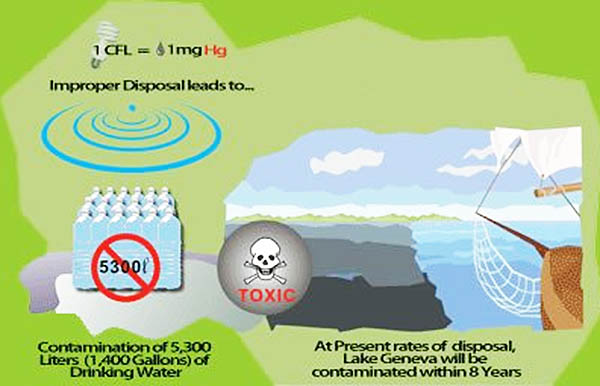From: The Dark Side Of CFLs
http://www.greenmuze.com/blogs/guest-bloggers/1031-the-dark-side-of-cfls.html
… More than 98% of used CFLs end up in landfills each year. That is 675 million for the year 2007 according to the National Geographic Society. Each CFL contains about 5 milligrams of elemental mercury as well as other poisonous gases. When mercury enters water sources, biological processes change the chemical form to methylmercury which is the organic, more toxic form found in fish. Methylmercury bio-accumulates through the food chain and once in the body can affect developing fetuses, children and adult nervous systems.
Methylmercury will not stay in landfills as it easily gets transported through the water table. Throwing CFLs into landfills will contaminate the soil, the water table and eventually the air.
More than 60,000 children are born each year in the United States with neurodevelopment impairments caused by exposure in the womb to methylmercury compounds, according to new estimates by an expert panel convened by the National Academy of Science’s Year 2000.
Beware of a broken CFL, as each broken lamp should be considered similar to a toxic spill and care needs to be taken cleaning them up. The manufacturing of CFLs also exposes workers to toxic levels of mercury. CFLs are manufactured mostly in China with virtually no health, safety, or environmental protection regulations. Ironically, most of the electricity used to manufacture CFLs comes from coal-fired generators. As CFLs increase in popularity, mercury exposure to workers, to electricians, to maintenance personal, to consumers, to water supplies, and to the living environment, will go ahead almost unchecked.
How many resources and pollutants does it take to make a light bulb?
“The reality is, even energy-efficient products don’t always come from energy-efficient beginnings. Consider for a second what goes into producing, powering and transporting products around the world like…energy efficient light bulbs. Until they are manufactured in a carbon-neutral way, transported on low-emission vehicles and powered in our homes by cleaner energy—green products will never be as green as they can be,” explained the World Wild Life Fund in MacLean’s Magazine.
Many environmentalists ignore these facts and instead claim that CFLs put less mercury into the environment than what would have been created via a smoke stack to generate the additional electricity needed for regular light bulbs. This is not true. Not all electricity is generated by dirty coal-fired plants. Even if it was, this would still be an irrelevant point given that coal fired power plants could operate with 80% less mercury emissions. In any event, it does not apply to BC where 90% of electrical power comes from hydroelectric dams according to BC Hydro. In Canada, 58% of electrical generation is from hydro and 19% from coal, according to Industry Canada…


Also,
RE the repeated “incandescent related coal power plant mercury release is worse” type of arguments
1. The incandescent energy usage calculations are wrong, official Dept of Energy etc statistics
show only 1-2% of grid electricity is saved in a changeover to CFLs
2. Even on assumed energy savings, the argument does not hold for several reasons
http://ceolas.net/#li198x
3. An important point on future mercury release is the EPA admin (under Lisa Jackson) drive to reduce mercury emissions by 90% with new mandate enforcement on power plants, as referenced.